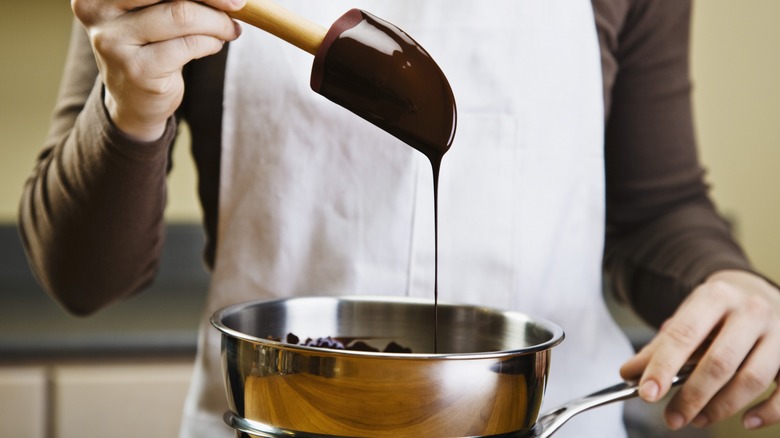Is There A Difference Between Tempered And Plain Melted Chocolate?
Whether you're crafting homemade sea salt brownie brittle or indulging in some dark chocolate raspberry cheesecake truffles, one essential ingredient you'll need is liquid chocolate. You might be wondering why we don't simply call it "melted chocolate." Well, there's a good reason for that. The way you melt chocolate can lead to two very different types of liquid chocolate: plain "melted" or "tempered" chocolate.
At first glance, melted and tempered chocolate might look the same — they both involve heating a chocolate bar until it becomes liquid. But, when you look closer, you'll notice some significant differences, particularly in their textures and appearances. Melted chocolate tends to have a dull color and a somewhat mushy, syrupy texture. On the other hand, tempered chocolate is glossy and smooth, and maintains a solid consistency similar to regular solid chocolate.
Making melted chocolate is quite straightforward. You just need to heat it until it goes from solid to liquid. However, the simplicity of this process comes at a cost. The heat causes the cocoa fat to melt and separate, forming an unstable network of tiny crystals on a microscopic level. This results in a dull, uneven appearance and a mushy texture. These problems won't be a big deal if you're incorporating the chocolate into a dish, like in traditional chocolate brownies. However, if you're crafting confections where the chocolate takes center stage, melted chocolate may not be the best choice.
Why tempered chocolate is better for baking
Tempered chocolate is also made by heating a chocolate bar, but the melting process is done with much more precision. The temperature is closely monitored and maintained within 113 to 131 degrees Fahrenheit using a thermometer, and this temperature range can vary depending on the type of chocolate. Once the chocolate is completely melted, it's then "seeded" with chunks of unmelted chocolate. The melted chocolate interacts with the cocoa powder in the unmelted chunks to cool it slowly and evenly and create stable crystals.
The hot chocolate mixture is then allowed to cool down while being vigorously stirred until it reaches a desirable temperature of around 82 to 90 degrees Fahrenheit. The outcome is a liquid chocolate that boasts an attractive, glossy sheen and an incredibly smooth texture. Once it cools and solidifies (preferably after it's been drizzled on top of desserts like chocolate pavlova), tempered chocolate produces a satisfying snap when broken apart. This is in stark contrast to the soft, limp shearing of melted chocolate when you pull at it.
This crisp snap, along with the smooth texture and glossiness, can be attributed to the stable crystalline structure of tempered chocolate born from the careful process above. Tempered chocolate is great for creating chocolate candies and treats. For instance, it makes for a tough, beautiful-looking chocolate shell for recipes like hot chocolate bombs. While tempering may demand more time and effort compared to simply melting chocolate, as you can see, it's well worth the extra work!

